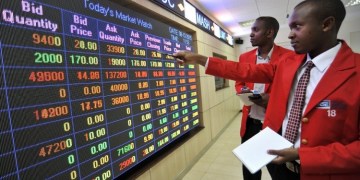Whether you are a scalper, day trader, swing trader or position trader, the need for having a good plan of action cannot be overemphasized. A good strategy guides your trading decisions, provides you with the necessary market information and helps you manage risks you will come across while trading.
To come up with a winning strategy, a trader needs to ask himself honest questions, learn from your mistakes & that of other traders, and be ready to study and learn how the capital market operates.
A trader should also be willing to evaluate his trading strategy if he is not getting the desired results, and make the needed adjustments.
We will discuss seven important points that day traders must note when trading in the Kenyan capital markets.
In this article
1. Create Time for Trading
Trading is a serious business and needs to be taken as a day job rather than a side gig. It can be time consuming and require a lot of studying. It can also be very stressful when you lose.
A trader needs to dedicate ample time to trading if he hopes to be successful. The capital markets are volatile and any lack of concentration can see a trader recording losses.
For example, when trading in a fast-moving market like the forex market, you cannot afford to be absent minded, especially when you are trading using leverage. The markets could change anytime and your funds could be lost.
You should have time to make a well though plan for entering any position, and have a strong reason for making a trade. Taking a passive approach & trading a stock or currency pair based on someone else’s call could cause losses to you.
If you don’t want to actively manage, then you should stick to investing in Mutual Funds & Fixed return asset classes.
2. Understand Market Cycles
Market emotions are not predictable but there is certainly a pattern in their movements.
There are four phases of a market cycle
- Accumulation phase
- Mark-up phase
- Distribution phase
- Mark-down phase
Phase one- The Accumulation Phase
Sometimes a market reaches its lowest point where prices of stock are at their lowest point and begin to consolidate. Some experienced & institutional investors take advantage of this and begin to buy assets at very low prices with the hope that a recovery is about to begin.
This class of investors are risk takers and don’t like to follow the herd. They are called contrarians. If they are wrong and the price of the stock does not recover, they could lose money.
An example of a rally can be when the share price of Kenya’s Safaricom consolidate first & then appreciated from around Kes. 24 in 2020 to Kes. 44 in 2021 on almost an year long Bull Run.
Phase Two- The Mark-Up Phase
In this phase, the market begins to recover and stabilize. The price of a stock begins to move higher as in the example of Safaricom above.
The media begins to say that the storm may be over and soon those experienced investors who had bought assets in the accumulation phase begin to make profits. Skeptical investors also begin to come back to the market.
Phase Three- The Distribution Phase
In this phase, prices are still high but investors begin to fear the market may become bearish some begin to take their profits while they can.
Phase Four- The Mark- Down Phase
In this phase prices begin to sink and the market becomes bearish. Some investors sell their stock to cut their losses at this point while some remain optimistic of a rally and try to wait out the storm.
Apart from understanding market phases, a trader also needs to know the market peak and off-peak periods.
Peak periods may be early in the morning when the market has just opened and queued orders begin to be executed. The servers will be very busy during the first twenty to twenty-five minutes of business commencement. At this period the prices of stocks fluctuate only to stabilize later.
If you expect the markets to be volatile & unpredictable during certain hours, it is best to sit out & watch the market for a while before diving in.
3. Don’t Trade with all your Life Savings
Statistics have shown that most day traders trading in the forex & derivatives markets lose money. When a trader enters the market there are two possible ways it ends – Profit or Loss.
Keeping this in mind, a trader should prepare for both scenarios and only trade with money that he can afford to live without. As a general rule, never stake more than 2% of the money in your trading account on a single trade.
4. Be Wary of Trading Scams
Traders in Kenya should be wary of investment scams. Rogue brokers without licenses and sometimes cloned licenses operate in the market too. The Capital Markets Authority regulates the capital market in Kenya and grants licenses accordingly.
Traders should always check with the CMA for a list of licensed brokers before patronizing any broker.
For example, there are only 6 CMA authorized Non-Dealing Online brokers for offering Forex Trading in Kenya to retail traders which include FXPesa, Scope Markets, Exinity Limited, Pepperstone, Windsor Markets, HotForex. You should only open an account with these brokers if you are looking to trade forex.
For trading stocks & derivatives on shares listed on NSE, you should trade with NSE regulated Stock brokers like Sterling Capital, AIB Capital, Genghis Capital etc.
5. Keep Track of the Market News
When trading with real money, traders also must be aware of global events like politics, wars etc.
Keep in mind that Central Banks always work according to their manifesto which may include things like increasing their Interest Rates etc. This could affect your trade.
If you are a stock trader for example, before deciding to trade any company’s stock, an analysis should be carried out on the financials of the company to gather information which would let you understand the risks associated with the stock.
6. Avoid Trading Illiquid stocks
Illiquid stocks are stocks of small public companies and are difficult to sell and convert to cash. Positions in stocks with low liquidity will be harder to get out of.
If you are a day trader, you should close your position before the end of the same business day. The difference between the stock price at the beginning and end of the day constitutes your profit or loss.
In cases of derivatives like futures on NSE, you are trading using margin money, and you could lose a lot of money if the position goes against you before the end of the settlement period. An outcome you may not be prepared for.
7. Trade Instruments that you Understand
Diversification of risk can be a good thing for experienced traders but if you are a beginner, it is better to focus on two or three stocks or instruments that you understand, study them properly and trade them only during the market hours.
Focusing on several stocks or many forex pairs (if you are a forex trader) at a time as a beginner will not give you enough time to study and analyze properly the instruments that you actually understand. This in turn is a recipe for disaster.
For example, if you are a forex trader, then stick to major currency pairs like EUR/USD, GBP/USD etc. If you are a stock trader, then you should stick to trading high volume stocks on the NSE, and avoid any illiquid stocks.
Similarly, if you want to trade foreign stocks listed on major exchanges, you can trade it as a CFD via licensed forex brokers.
Or you can buy shares via licensed stock brokers. For example, Kenyan investors can buy or trade US Stocks via Hisa broker. They offer fractional shares in companies like Apple, Tesla, Alphabet etc.
These fractions are created when an investor chooses to reinvest his dividend by acquiring more stock. The dividend may not be enough to buy a round figure of stock so the investor may be allotted fractions of stock.
8. Use Stop Loss and stop limit Orders
A trader may not be able to sit in front of the screen all day monitoring price fluctuations. Stop loss orders are automated to monitor the market and act on behalf of the trader.
Stop Loss Order explained
A stop loss order is an instruction given by trader to broker to either buy or sell an asset once the price of the stock moves above a set price. This set price is called the Stop price. Once the Stop Price is crossed, a market order to buy or sell is triggered. The broker charges a fee for the stop loss order.
Example
Adimu is a Kenyan day trader. She believes company XYZ stocks will appreciate in value before the end of the day. She buys Safaricom Ltd. stock hoping to sell when the price rises.
Price per unit of Safaricom stock = 38 Kes.
Number of units bought= 100 units
Total capital invested= 3800 Kes (38 x 100)
Stop Price = 1 Kes
Unfortunately for her the price of the stock suddenly begins to go down while she is away. Once the price goes down by 1 Kes. to 37 Kes. so her automated stop loss order exits her trading position and sells off the stock at the current market price to a willing buyer.
Her loss is limited to just 100 Kes (3800 – 3700)
If the stop order was not in place, she stood the risk of losing more money if the price kept going down. If she was trading with margin, then her risk would be higher.
Limit Orders
Brokers also have limit-orders on their platforms, just like stop-loss orders. Limit orders can also be used to buy stock when the price moves above the set price. The Price and units of stock to be bought are set by her. Once that set price is crossed the system or broker’s platform automatically buys the specified amount of stock on her behalf using the money in her account.
Limit orders explained
Limit orders are similar to stop loss orders in every way except that the Stop Price is specific. Using the example above, for a Limit Order, let’s say a trader believes that the price of Safaricom would rise from Kes. 35 & go to Kes 40 from there.
So, the trade could set a limit order at Kes. 35 with take profit at 40. Once the price of stock reaches 35 the trader’s position will automatically be opened with take profit at 40.
9. Don’t Ignore Demo Account
Aspiring traders should hone their skills using Demo trading accounts for at least three months before going live.
A demo account is offered for free by most brokers.
A demo trading account allows a trader to practice trading under real market-like conditions. You are trading actual instruments at real market pricing, just that no real money is involved.
When choosing a broker to open your trading account, care must also be taken not to patronize unlicensed brokers. The Capital Markets Authority has a lot of investor education information on their website and traders in Kenya should visit regularly to get the latest updates.
Related:
How to Find the Best Forex Broker in Kenya
First time Trader? You must find the balance with patience
Top 5 Successful Forex Traders in Kenya




